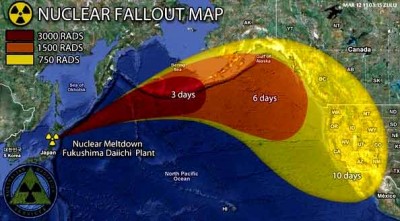Forbidden Land Of Fukushima – A Photo Journal

In July of 2013, journalist Yoichi Shimatsu and I made a trip to the vicinity of the wrecked reactors at Fukushima nuclear power plant no. 1 (FNPP#1). We traveled through the area which had been devastated by the March 11, 2011 tidal wave and subsequent nuclear meltdowns that occurred at FNPP#1. We were as close as nine or ten kilometers away from the actual reactors and I measured over 0.5 microsieverts per hour background radiation on my dosimeter. This was in a place where we saw one lady tending to her yard and apparently living there, but there were not too many other people around other than Tepco workers or secret police (1) .
Locations visited included Nakaso, a seaside town on the southern border of Fukushima just north of Ibaraki; Hisanohama, a fishing village about 14 km south of FNPP#1; and finally Hirano town (ghost town) and J-village which acts as Tepco worker headquarters and is about 12 km from the NFPP#1 reactors.
When we arrived at Nakaso my dosimeter (“Terra-P” made in the Ukraine) measured normal background radiation. However, after we had dropped off our bags at the hotel and traveled farther north, radiation levels increased. *(I have used the dosimeter on a commercial flight where it measured 2 – 3 microsieverts per hour which is normal at high altitudes; and in the US where background radiation was the similar to most of Tokyo, about 0.1 – 0.15 microsieverts per hour.)

Photo 1: This sculpture exhibits Nakaso’s tradition of fishing, an industry now permanently endangered due to the accident.

Photo 2: Yoichi Shimatsu walks along the damaged seawall at Nakaso beach, small islands just off the coast actually disappeared due to the tsunami!

Photo 3: Pylons stored along the beach, the earthquake and tsunami damaged the coastline along Nakaso town

Photo 4: Yoichi departs from the seaside hotel at Nakaso

Photo 5: Boys play baseball in a lonely Nakaso setting

Photo 6: Richard Wilcox arrives at the fishing town of Hisanohama, background radiation was noticeably higher (from 0.17 inland – 0.25 on the coast), 14 km from the Fukushima reactors.

Photo 7: The tumultuous seacoast of Hisanohama

Photo 8: A residential area destroyed by the tsunami now overgrown by weeds

Photo 9: Yoichi leads the way toward the now idle fishing port

Photo 10: Abnormally high radiation levels: 0.27 microsieverts per hour

Photo 11: Hisanohama fishing port: waiting for the day when fishers can go back to work

Photo 12: A perfectly good parking lot is removed due to radioactive contamination, to be collected and stored as low level rad waste

Photo 13: This fishing net lying by the road measured 0.51 microsieverts per hour!

Photo 14: Beauty survives in Fukushima’s haunted landscape with the seasonal Hydrangea flower

Photo 15: Next stop: Hirano town and J-Village

Photo 16: A thermal power plant sits between Fukushima’s two nuclear power plants, numbers one and two, which are 10 km apart from each other. J-Village, a former sports complex, is conveniently located there as worker headquarters.

Photo 17: Leaving J-Village on the road to the now abandoned Tomioka town, Yoichi looks out toward the Abukuma mountains in the distance.

Photo 18: Hirano town itself had been decontaminated pushing radiation levels back to “normal.” The small town offered beautiful countryside vistas of the “Abukuma” mountain range. However, as soon as we reached the outskirts of the town levels jumped to 0.52 micro sieverts per hour, about four or five times the level considered safe for long-term habitation. Background radiation in this area (outside the decontaminated zone of Hirano town) ranged from 0.45 to over 0.5 microsieverts per hour.

Photo 19: On the way to the beach where radiation is irreversibly deposited in the coastal sediments: “Most of radiocesium in the coastal sediments is incorporated into lithogenic fractions, and this incorporation is almost irreversible. Accordingly, the biological availability of sedimentary radiocesium is relatively low, but continuous monitoring of radiocesium inmarine biota is highly recommended because significant amounts of radiocesium have been accumulated in the sediment” (2).
Just along this seacoast to the north is the infamous FNPP#1, spewing 60 billion becquerels of radiation into the ocean every day. That’s 21.9 trillion bq per year. The ocean is a big place but recall that the limit for food in Japan is 100 bq per kg. If this radiation were spread extensively through “bio-magnification” (when an organism absorbs poisons at a rate faster than they are excreted) among the ocean’s fish population it would (and already has in many cases) make many of them over the safety limit.
“Michio Aoyama, a senior researcher of marine chemistry at the Japan Meteorological Agency’s Meteorological Research Institute, estimated that 30 billion becquerels of radioactive cesium and another 30 billion becquerels of radioactive strontium continue to leak into the outer ocean every day” (3).

Photo 20: Near Hirano we saw thousands of huge sacks of low level radioactive waste piled under a bridge

Photo 21: As we walked back to town, I wondered where the low level radioactive waste would be stored, and where the road we were on would lead us.
Richard Wilcox holds a Ph.D. in Environmental Studies from a social science, holistic perspective. He teaches at a number of universities in the Tokyo, Japan area. His articles on environmental topics including the Fukushima nuclear disaster are archived at http://wilcoxrb99.wordpress.com/ and he can be contacted at [email protected]
Notes
1. My Trip To The Fukushima Nuclear Disaster Zone (Part One)
http://therebel.org/news/wilcox/my-trip-to-the-fukushima-nuclear-disaster-zone-part-one/
2. Japan Experts: Contamination from Fukushima “is almost irreversible” in coastal sediments
http://enenews.com/japan-experts-contamination-is-almost-irreversible-in-coastal-sediments
3. ANALYSIS: Contaminated water flowing into ocean despite Abe’s claim
http://ajw.asahi.com/article/0311disaster/fukushima/AJ201309200053

